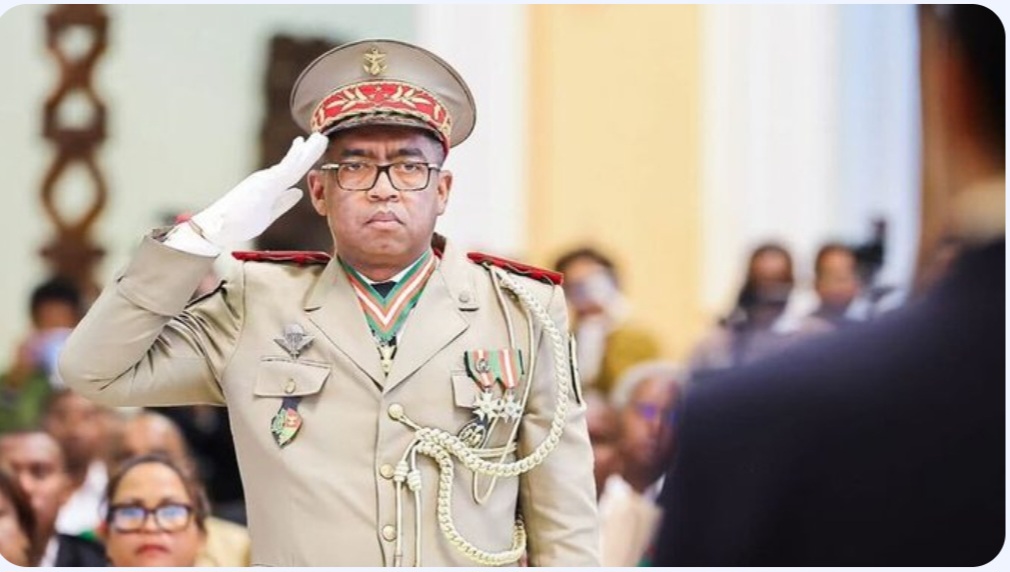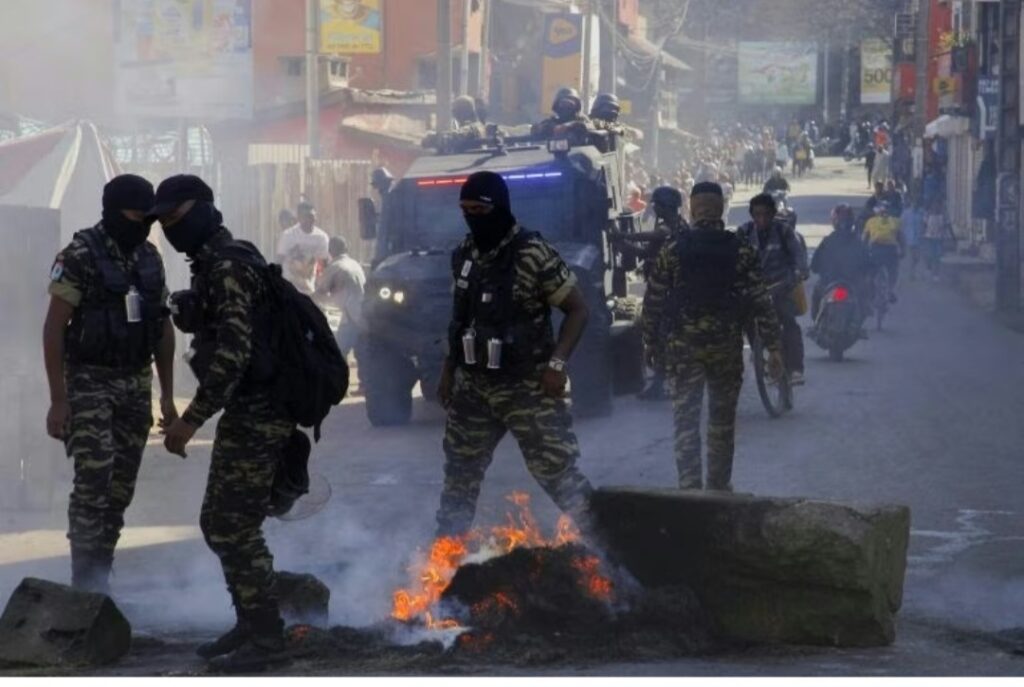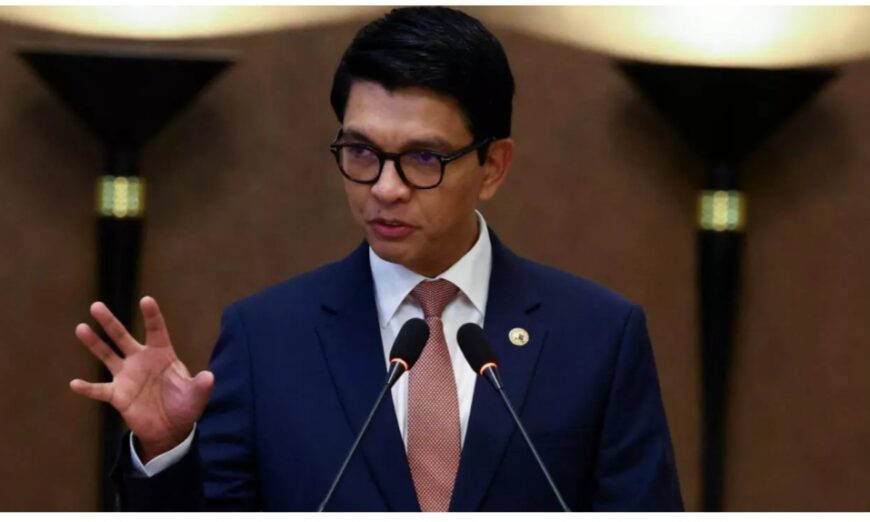Madagascar’s President Andry Rajoelina, gestures as he appoints military general Ruphin Fortunat Zafisambo as Prime Minister, October 6, 2025.

General Ruphin Fortunat Zafisambo.

Police officers in Madagascar clear a burning barricade after dispersing a crowd during a nationwide youth-led protest..
Madagascar’s President Andry Rajoelina has named army general Ruphin Fortunat Zafisambo as the new prime minister in an effort to quell growing youth-led protests.
Rajoelina said the country needed leadership capable of restoring order and public trust. However, the move follows fears of a coup and signals rising military influence in government.
Protesters under the Gen Z Mada movement rejected the appointment and demanded Rajoelina resign within 48 hours. Demonstrations began in September over water and power cuts and have escalated due to corruption and unemployment.
Security forces clashed with protesters in multiple cities as unrest continued into a third week. The UN reports at least 22 deaths during the protests. Last week, Rajoelina dismissed Prime Minister Christian Ntsay, a civilian, and his entire cabinet in an attempt to placate the protesters.
In the latest in days of youth-led marches, security forces dispersed hundreds of demonstrators with tear gas in Madagascar’s capital Antananarivo, injuring at least one, AFP reporters saw.
Sparked by anger against persistent water and power cuts in the impoverished Indian Ocean island, the demonstrations started on September 25 and have grown into an angry campaign for Rajoelina to resign.
“With wisdom, I have decided to appoint Ruphin Fortunat Dimbisoa Zafisambo, divisional general, as prime minister of the government,” Rajoelina said late Monday in a declaration at the presidential palace.
The new premier should “serve the people” and be “someone clean, with integrity, and who works quickly”, he said, promising he was “ready to save Madagascar”.
The Gen Z movement that rallied the protests on social media responded by repeating calls for Rajoelina to resign.
It said it was giving him a 48-hour “ultimatum” to “respond favourably” to their demands.
“As long as Andry Rajoelina remains in power, we will continue to fight,” the group said on social media.
Rajoelina’s move to sack his entire government last week failed to placate the demonstrators.
University students and residents gathered near the University of Ankatso on the outskirts of the capital on Monday, the 12th day of the movement.
They then marched towards the city centre, where they were stopped by a barricade put up by security forces.
Clashes erupted throughout the afternoon, with at least one young man wounded and evacuated to the main hospital, AFP reporters saw.
“There are about 120 hours of power cuts per week where I live,” said 21-year-old protester Tommy Fanomezantsoa.
“We are protesting for everyone’s sake,” he told AFP. “The president is not listening to the anger of the people at the bottom. He always does what he wants.”
The Ankatso district was the birthplace of a 1972 revolt that led to the ousting of the first president of the poverty-stricken island, Philibert Tsiranana.
“The future of this country depends on me, on you, on all of us,” one of the protest leaders told the crowd of several hundred people, urging them not to allow the movement to lose momentum.
“We can clearly see that democracy in Madagascar is not respected at all,” said another protest leader.
“They are even destroying it with brutality,” he said.
He was referring to a United Nations statement last week that at least 22 people had been killed in the protests and more than 100 wounded, a figure rejected by the authorities.
The UN also condemned what it called a heavy-handed response by security forces, including the use of live ammunition.
AFP journalists witnessed a pregnant woman going into convulsions as crowds of people, including many children, fled from police in the hilly cobbled streets of the Amparibe neighbourhood.
Local media also reported a protest in the southern city of Toliara, where demonstrators burned tyres.
Ahead of Zafisambo’s appointment, some were unimpressed by Rajoelina’s promise of a change of prime minister.
“We don’t want him to listen to people in his office, we want him to get out on the ground,” said demonstrator Fanomezantsoa.
He said he had been unemployed since the supermarket where he worked was looted on the first night of the protests.
“We will continue until we get results,” he said.
The Christian Council of Churches of Madagascar (FFKM) said it was prepared to mediate between the government and protesters.
The Gen Z movement has taken inspiration from similar youth-led movements in Bangladesh, Nepal and Indonesia, waving a pirate flag from the Japanese manga comic One Piece.
Despite its natural resources, Madagascar remains among the world’s poorest countries.
Nearly three-quarters of its population of 32 million were living below the poverty line in 2022, according to the World Bank.
Police fired tear gas at demonstrators on the streets of the capital, Antananarivo, on Monday, the start of a third consecutive week of protests. The unrest began over water and electricity cuts, but has evolved into broader anti-government anger against Rajoelina’s administration.
Protesters have gathered in cities across the country, with local TV stations broadcasting footage of people at rallies being confronted by police in the cities of Toliara and Antsiranana, also known as Diego Suarez.
In Antananarivo, a Reuters reporter said police fired tear gas at the protesters, most of whom were university students.
The United Nations said on Monday that 22 people have been killed since the protests began, and more than 100 people have been injured, figures rejected by the government.
The protests against Rajoelina’s government began on September 25 in the capital, with thousands of demonstrators taking to the streets and erecting barricades with rocks and tyres.
They were organised by Gen Z Madagascar, a social media youth group describing itself as a “peaceful, civic movement”. Organisers say they have taken inspiration from youth-led movements in Nepal and Morocco.
About a third of Madagascar’s 30 million people have access to electricity, according to the International Monetary Fund. Daily power cuts often exceed eight hours, and Jirama, the state energy company, has been accused of corruption and mismanagement, fuelling public anger.
“People don’t have refrigeration for medication, don’t have water for basic hygiene, and then there’s massive corruption,” Ketakandriana Rafitoson, the global vice chair of Transparency International, told Reuters.
“These protests were triggered by visceral grievances that go to the heart of daily life.”
Though the protests started peacefully on their first day on 25 Septmeber, they turned chaotic as unrest spread through Antananarivo after police employed tear gas and rubber bullets.
Shops were ransacked, and the homes of some lawmakers were damaged.
In response to the first night of protests, authorities instituted an overnight curfew to prevent people from gathering in the evenings.
That has set a confrontational tone between protesters and police in following rallies.
Several demonstrations have taken place since and have grown into a movement more broadly channeling public discontent with the performance of Rajoelina’s government.
Rajoelina, 51, came to power in a 2009 military coup, having himself campaigned for reform. He briefly stepped down in 2014 but was elected in 2018.
A former DJ and media tycoon, he now faces the biggest challenge to his rule in years, experts say. Rajoelina had sacked his cabinet in an attempt to appease the protesters.
A government spokesperson told Reuters that attempts to engage demonstrators have been repeatedly rebuffed.
“Unfortunately, despite our efforts, no clear or structured leadership has emerged to engage in constructive talks,” the spokesperson said.
Rajoelina has previously rejected calls for his resignation and accused those calling for him to step down of wanting to “destroy our country”.
